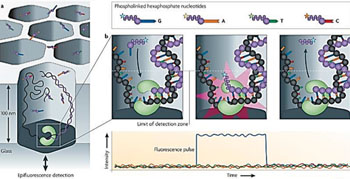Tissue Typing Method Revolutionizes Field of Stem Cell Transplantation
By LabMedica International staff writers
Posted on 24 Jan 2016
Saliva and blood samples can be typed using a new system that allows scientists to obtain very high quality information about a patient and donor's tissue types, enabling them to make the best possible matches. Posted on 24 Jan 2016
As well as improving outcomes, the technology should be faster than previous techniques, allowing the potential for more donors to be typed every year. Typing more donors would increase the chance of every patient finding a well matched donor—a vital move as currently only 60% of transplant patients receive the best possible match.

Image: Single Molecule Real-Time (SMRT) DNA sequencing technology (Photo courtesy of Pacific Biosciences).
The technology, known as Third Generation Sequencing, also allows scientists working for the Anthony Nolan charity (London, UK) a further understanding of donor-patient compatibility in stem cell transplantation. The new highly accurate reads of the patient and donor's human leukocyte antigen (HLA) types will allow the investigators to identify currently unknown factors which contribute to the success or failure of a stem cell transplant. This information could prove to be invaluable for improving the success of future transplants.
The latest technology resolves this by generating exceptionally long DNA read lengths and by sequencing different tissues types in isolation. The Anthony Nolan scientists are working with new Single Molecule Real-Time (SMRT) DNA sequencing technology (Pacific Biosciences; Menlo Park, CA, USA). SMRT Sequencing is built upon two key innovations: zero-mode waveguides (ZMWs) and phospholinked nucleotides. ZMWs allow light to illuminate only the bottom of a well in which a DNA polymerase/template complex is immobilized. Phospholinked nucleotides allow observation of the immobilized complex as the DNA polymerase produces a completely natural DNA strand.
Katy Latham, PhD, Director of Laboratories at Anthony Nolan, said, “The implications of this technology could be enormous, allowing for accurate HLA typing in a single experiment and making redundant the need for multiple experiments and cross-referencing of results. This is significant as high resolution HLA typing has been shown to significantly improve outcomes when stem cells transplant recipients and their unrelated donors are matched very closely.”
Related Links:
Anthony Nolan
Pacific Biosciences














